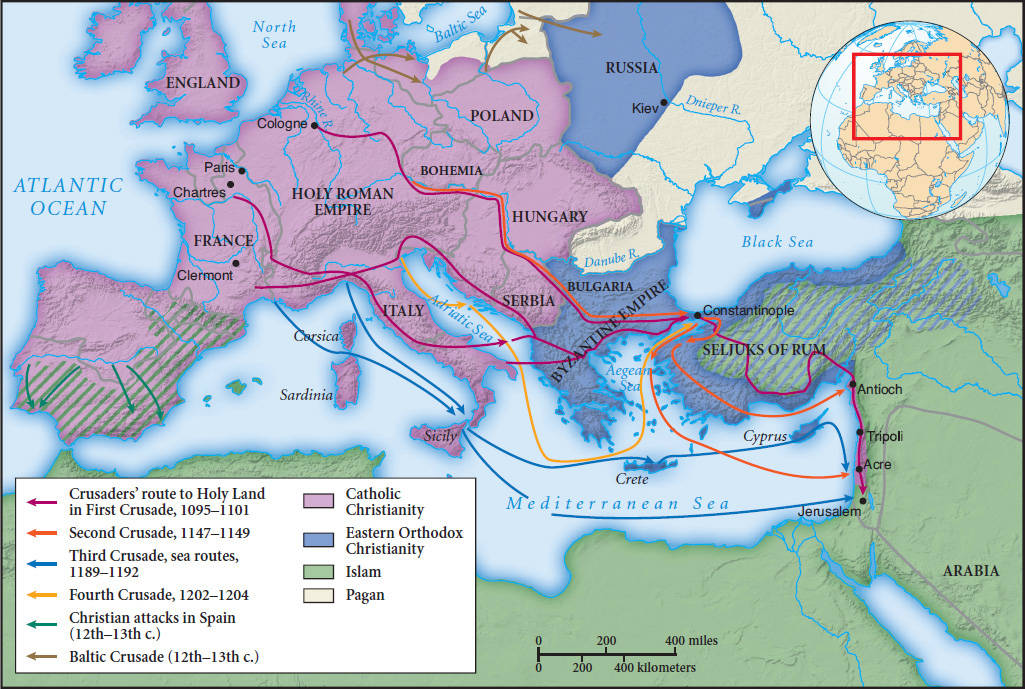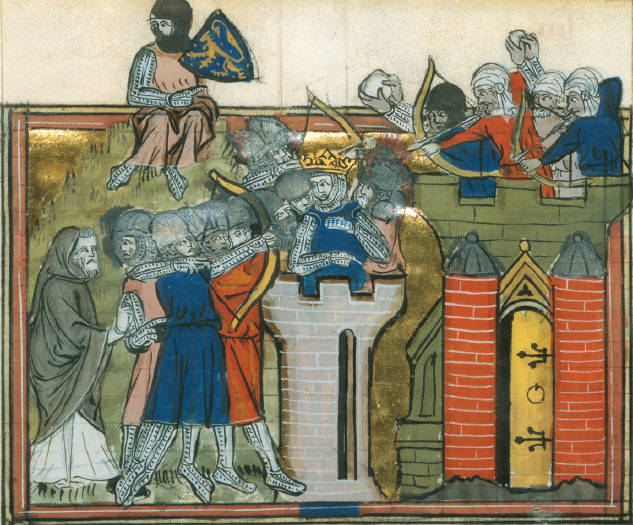Europe Outward Bound: The Crusading Tradition
Change
Question
ULZ45jpeIZx4FeuDVqdp9vZnU6Es60mRoPv8/kDSh+A78HVaL/Ew3wsRWxL6yrE9uvFxAEsDGUYtUPcCbvzMpvNtwwaav8Az[Answer Question]
Accompanying the growth of a new European civilization after 1000 were efforts to engage more actively with both near and more distant neighbors. This “medieval expansion” of Western Christendom took place as the Byzantine world was contracting under pressure from the West, from Arab invasion, and later from Turkish conquest. (See Map 10.1.) The western half of Christendom was on the rise, while the eastern part was in decline. It was a sharp reversal of their earlier trajectories.
Expansion, of course, has been characteristic of virtually every civilization and has taken a variety of forms—territorial conquest, empire building, settlement of new lands, vigorous trading initiatives, and missionary activity. European civilization was no exception. As population mounted, settlers cleared new land, much of it on the eastern fringes of Europe. The Vikings of Scandinavia, having raided much of Europe, set off on a maritime transatlantic venture around 1000 that briefly established a colony in Newfoundland in North America, and more durably in Greenland and Iceland. (See Portrait of Thorfinn Karlsfeni.) As Western economies grew, merchants, travelers, diplomats, and missionaries brought European society into more intensive contact with more distant peoples and with Eurasian commercial networks. By the thirteenth and fourteenth centuries, Europeans had direct, though limited, contact with India, China, and Mongolia. Europe clearly was outward bound.
Nothing more dramatically revealed European expansiveness and the religious passions that informed it than the Crusades, a series of “holy wars” that captured the imagination of Western Christendom for several centuries, beginning in 1095. In European thinking and practice, the Crusades were wars undertaken at God’s command and authorized by the pope as the Vicar of Christ on earth. They required participants to swear a vow and in return offered an indulgence, which removed the penalties for any confessed sins, as well as various material benefits, such as immunity from lawsuits and a moratorium on the repayment of debts. Any number of political, economic, and social motives underlay the Crusades, but at their core they were religious wars. Within Europe, the amazing support for the Crusades reflected an understanding of them “as providing security against mortal enemies threatening the spiritual health of all Christendom and all Christians.”23 Crusading drew on both Christian piety and the warrior values of the elite, with little sense of contradiction between these impulses.
The most famous Crusades were those aimed at wresting Jerusalem and the holy places associated with the life of Jesus from Islamic control and returning them to Christendom (see Map 10.4). Beginning in 1095, wave after wave of Crusaders from all walks of life and many countries flocked to the eastern Mediterranean, where they temporarily carved out four small Christian states, the last of which was recaptured by Muslim forces in 1291. Led or supported by an assortment of kings, popes, bishops, monks, lords, nobles, and merchants, the Crusades demonstrated a growing European capacity for organization, finance, transportation, and recruitment, made all the more impressive by the absence of any centralized direction for the project. They also demonstrated considerable cruelty. The seizure of Jerusalem in 1099 was accompanied by the slaughter of many Muslims and Jews as the Crusaders made their way, according to perhaps exaggerated reports, through streets littered with corpses and ankle deep in blood to the tomb of Christ.

Crusading was not limited to targets in the Islamic Middle East, however. Those Christians who waged war for centuries to reclaim the Iberian Peninsula from Muslim hands were likewise declared “crusaders,” with a similar set of spiritual and material benefits. So too were Scandinavian and German warriors who took part in wars to conquer, settle, and convert lands along the Baltic Sea. The Byzantine Empire and Russia, both of which followed Eastern Orthodox Christianity, were also on the receiving end of Western crusading, as were Christian heretics and various enemies of the pope in Europe itself. Crusading, in short, was a pervasive feature of European expansion, which persisted as Europeans began their oceanic voyages in the fifteenth century and beyond.

Surprisingly perhaps, the Crusades had little lasting impact, either politically or religiously, in the Middle East. European power was not sufficiently strong or long-lasting to induce much conversion, and the small European footholds there had come under Muslim control by 1300.The penetration of Turkic-speaking peoples from Central Asia and the devastating Mongol invasions of the thirteenth century were far more significant in Islamic history than were the temporary incursions of European Christians. In fact, Muslims largely forgot about the Crusades until the late nineteenth and early twentieth centuries, when their memory was revived in the context of a growing struggle against European imperialism.
In Europe, however, crusading in general and interaction with the Islamic world in particular had very significant long-term consequences. Spain, Sicily, and the Baltic region were brought permanently into the world of Western Christendom, while a declining Byzantium was further weakened by the Crusader sacking of Constantinople in 1204 and left even more vulnerable to Muslim Turkish conquest. In Europe itself, popes strengthened their position, at least for a time, in their continuing struggles with secular authorities. Tens of thousands of Europeans came into personal contact with the Islamic world, from which they picked up a taste for the many luxury goods available there, stimulating a demand for Asian goods. They also learned techniques for producing sugar on large plantations using slave labor, a process that had incalculable consequences in later centuries as Europeans transferred the plantation system to the Americas. Muslim scholarship, together with the Greek learning that it incorporated, also flowed into Europe, largely through Spain and Sicily.
SUMMING UP SO FAR
Question
Y936KJXNiTYSzVGva1EcbcfGiDQsLBNI7XEvHQ6K8LGgWauEmlyPkaqILI0h4Gjl40Y1/zmYxX07c2Qg8GW2WXO9llGAZ8ga34I5bgaF8obAdMOim8XJWJ5pgfGXPPiHUDZVJCUuLBJJHlFgc6zLM7vaFxx5R6vlHMNEXw==[Answer Question]
If the cross-cultural contacts born of crusading opened channels of trade, technology transfer, and intellectual exchange, they also hardened cultural barriers between peoples. The rift between Eastern Orthodoxy and Roman Catholicism deepened further and remains to this day a fundamental divide in the Christian world. Christian anti-Semitism was both expressed and exacerbated as Crusaders on their way to Jerusalem found time to massacre Jews, regarded as “Christ-killers,” in a number of European cities, particularly in Germany. Such pogroms, however, were not sanctioned by the Church. A leading figure in the second crusade, Bernard of Clairvaux, declared that “it is good that you march against the Muslims, but anyone who touches a Jew to take his life, is as touching Jesus himself.”24 European empire building, especially in the Americas, continued the crusading notion that “God wills it.” And more recently, over the past two centuries, as the world of the Christian West and that of Islam collided, both sides found many occasions in which images of the Crusades, however distorted, proved politically popular or ideologically useful.25